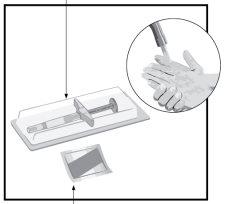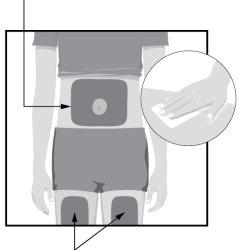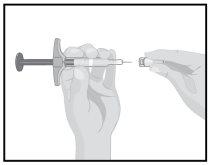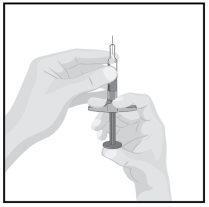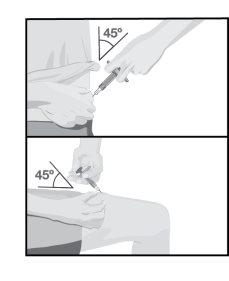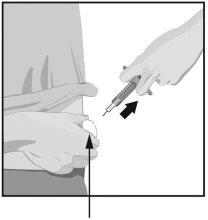
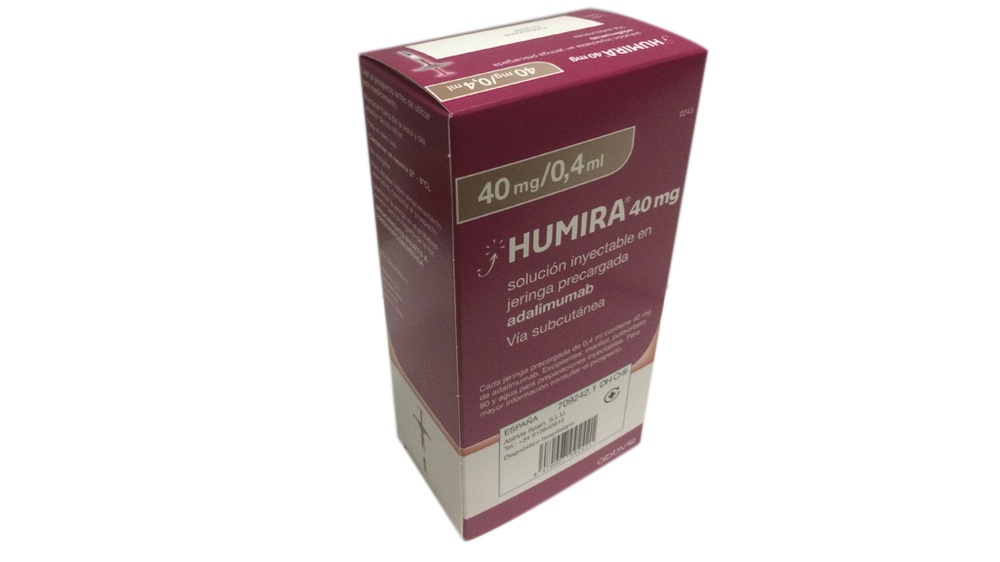
Хумира 40 мг раствор для инъекций в предварительно заполненном шприце


Инструкция по применению Хумира 40 мг раствор для инъекций в предварительно заполненном шприце
Введение
Инструкция: Информация для пациента
Хумира 40мг раствор для инъекций в предварительно заполненном шприце
адалимумаб
Прочитайте внимательно всю инструкцию перед началом использования этого лекарства, поскольку она содержит важную информацию для вас.
- Сохраните эту инструкцию, поскольку вам может потребоваться прочитать ее снова.
- Ваш врач даст вам карту информации для пациента, содержащую важную информацию о безопасности, которую вам необходимо знать перед началом использования и во время лечения Хумирой. Сохраните эту карту информации для пациента.
- Если у вас есть какие-либо вопросы, проконсультируйтесь с вашим врачом или фармацевтом.
- Это лекарство было назначено только вам и не должно быть передано другим людям, даже если у них такие же симптомы, как у вас, поскольку оно может нанести им вред.
- Если вы испытываете побочные эффекты, проконсультируйтесь с вашим врачом или фармацевтом, даже если это побочные эффекты, которые не указаны в этой инструкции. См. раздел 4.
Содержание инструкции
- Что такое Хумира и для чего она используется
- Что вам нужно знать перед началом использования Хумиры
- Как использовать Хумиру
- Возможные побочные эффекты
- Хранение Хумиры
- Содержание упаковки и дополнительная информация
- Как вводить Хумиру
1. Что такое Хумира и для чего она используется
Хумира содержит активное вещество адалимумаб.
Хумира используется для лечения
- ревматоидного артрита
- ювенильного идиопатического полиартрита
- артрита, ассоциированного с энтезитом
- анкилозирующего спондилита
- аксиального спондилоартрита без радиографических признаков анкилозирующего спондилита
- псориатического артрита
- псориаза в виде бляшек
- гидраденита
- болезни Крона
- язвенного колита
- неинфекционного увеита
Активное вещество Хумиры, адалимумаб, является человеческим моноклональным антителом. Моноклональные антитела - это белки, которые атакуют конкретную мишень.
Мишенью адалимумаба является белок, называемый фактором некроза опухоли (TNFα), который участвует в иммунной системе (защите) и находится в повышенных уровнях при воспалительных заболеваниях, описанных выше. Блокируя TNFα, Хумира снижает воспалительный процесс при этих заболеваниях.
Ревматоидный артрит
Ревматоидный артрит - это воспалительное заболевание суставов.
Хумира используется для лечения ревматоидного артрита средней и тяжелой степени у взрослых. Возможно, вам будут назначены другие лекарства, модифицирующие заболевание, такие как метотрексат. Если ответ на эти лекарства не будет достаточным, вам будет назначена Хумира.
Хумира также может быть использована для лечения тяжелого, активного и прогрессирующего ревматоидного артрита без предыдущего лечения метотрексатом.
Хумира может снизить повреждение суставов, вызванное воспалительным заболеванием, и может помочь улучшить подвижность суставов
Ваш врач решит, должна ли Хумира быть использована с метотрексатом или в монотерапии.
Ювенильный идиопатический полиартрит
Ювенильный идиопатический полиартрит - это воспалительное заболевание суставов.
Хумира используется для лечения ювенильного идиопатического полиартрита у пациентов от 2 лет.
Возможно, вам будут назначены другие лекарства, модифицирующие заболевание, такие как метотрексат. Если ответ на эти лекарства не будет достаточным, вам будет назначена Хумира.
Ваш врач решит, должна ли Хумира быть использована с метотрексатом или в монотерапии.
Артрит, ассоциированный с энтезитом
Артрит, ассоциированный с энтезитом, - это воспалительное заболевание суставов и мест прикрепления сухожилий к кости.
Хумира используется для лечения артрита, ассоциированного с энтезитом, у пациентов от 6 лет. Возможно, вам будут назначены другие лекарства, модифицирующие заболевание, такие как метотрексат. Если ответ на эти лекарства не будет достаточным, вам будет назначена Хумира.
Анкилозирующий спондилит и аксиальный спондилоартрит без радиографических признаков анкилозирующего спондилита
Анкилозирующий спондилит и аксиальный спондилоартрит без радиографических признаков анкилозирующего спондилита - это воспалительные заболевания, поражающие позвоночник.
Хумира используется для лечения тяжелого анкилозирующего спондилита и аксиального спондилоартрита без радиографических признаков анкилозирующего спондилита у взрослых. Возможно, вам будут назначены другие лекарства. Если ответ на эти лекарства не будет достаточным, вам будет назначена Хумира
Псориатический артрит
Псориатический артрит - это воспалительное заболевание суставов, часто ассоциированное с псориазом.
Хумира используется для лечения псориатического артрита у взрослых. Хумира может снизить повреждение суставов, вызванное заболеванием, и может помочь улучшить подвижность суставов. Возможно, вам будут назначены другие лекарства. Если ответ на эти лекарства не будет достаточным, вам будет назначена Хумира.
Псориаз в виде бляшек
Псориаз в виде бляшек - это заболевание кожи, вызывающее красные, чешуйчатые, корковые и покрытые серебристыми чешуйками области. Псориаз в виде бляшек также может поражать ногти, вызывая их разрушение, утолщение и отслоение от ногтевого ложа, что может быть болезненным.
Хумира используется для лечения
- хронического псориаза в виде бляшек средней и тяжелой степени у взрослых и
- тяжелого хронического псориаза в виде бляшек у детей и подростков от 4 до 17 лет, которые не ответили на местную терапию и фототерапию.
Гидраденит
Гидраденит (иногда называемый обратным акне) - это хроническое и часто болезненное воспалительное заболевание кожи. Симптомы могут включать чувствительные узлы (шишки) и абсцессы (фурункулы), которые могут выделять гной. Обычно поражает определенные области кожи, такие как под грудью, в подмышках, внутренней поверхности бедер, паху и ягодицах. Также могут быть рубцы в пораженных областях.
Хумира используется для лечения
- гидраденита средней и тяжелой степени у взрослых и
- гидраденита средней и тяжелой степени у подростков от 12 до 17 лет.
Хумира может снизить количество узлов и абсцессов, вызванных заболеванием, и боль, обычно ассоциированную с этим заболеванием. Возможно, вам будут назначены другие лекарства ранее. Если ответ на эти лекарства не будет достаточным, вам будет назначена Хумира.
Болезнь Крона
Болезнь Крона - это воспалительное заболевание желудочно-кишечного тракта.
Хумира используется для лечения
- болезни Крона средней и тяжелой степени у взрослых и
- болезни Крона средней и тяжелой степени у детей и подростков от 6 до 17 лет.
Возможно, вам будут назначены другие лекарства ранее. Если ответ на эти лекарства не будет достаточным, вам будет назначена Хумира.
Язвенный колит
Язвенный колит - это воспалительное заболевание толстой кишки.
Хумира используется для лечения
- язвенного колита средней и тяжелой степени у взрослых и
- язвенного колита средней и тяжелой степени у детей и подростков от 6 до 17 лет
Возможно, вам будут назначены другие лекарства ранее. Если ответ на эти лекарства не будет достаточным, вам будет назначена Хумира.
Неинфекционный увеит
Неинфекционный увеит - это воспалительное заболевание, поражающее определенные части глаза.
Хумира используется для лечения
- взрослых с неинфекционным увеитом с воспалением, поражающим заднюю часть глаза.
- детей от 2 лет с хроническим неинфекционным увеитом с воспалением, поражающим переднюю часть глаза.
Это воспаление может привести к снижению зрения и/или появлению мушек в глазу (черных точек или тонких линий, движущихся по полю зрения). Хумира действует, снижая это воспаление.
Возможно, вам будут назначены другие лекарства ранее. Если ответ на эти лекарства не будет достаточным, вам будет назначена Хумира.
2. Что вам нужно знать перед началом использования Хумира
Не используйте Хумиру:
- Если вы аллергичны к адалимумабу или любому другому компоненту этого препарата (перечисленному в разделе 6).
- Если у вас активная туберкулезная инфекция или другие тяжелые инфекции (см. «Предостережения и меры предосторожности»). В случае появления симптомов любой инфекции, например, лихорадки, ран, усталости, проблем с зубами, важно сообщить об этом вашему врачу.
- Если у вас умеренная или тяжелая сердечная недостаточность. Важно сообщить вашему врачу, если у вас были или есть серьезные проблемы с сердцем (см. «Предостережения и меры предосторожности»).
Предостережения и меры предосторожности
Проконсультируйтесь с вашим врачом или фармацевтом перед началом использования Хумира.
Аллергические реакции
- Если у вас出现ит аллергическая реакция с симптомами, такими как сдавленность в груди, затруднение дыхания, головокружение, отек или сыпь, прекратите введение Хумира и немедленно свяжитесь с вашим врачом, поскольку в редких случаях эти реакции могут представлять угрозу для жизни.
Инфекции
- Если у вас есть любая инфекция, включая хроническую или локализованную инфекцию в какой-либо части тела (например, язва на ноге), проконсультируйтесь с вашим врачом перед началом лечения Хумирой. Если вы не уверены, свяжитесь с вашим врачом.
- При лечении Хумирой вы можете легче подвергаться инфекциям. Этот риск может быть выше, если у вас повреждены легкие. Эти инфекции могут быть тяжелыми и включать:
- туберкулез
- инфекции, вызванные вирусами, грибами, паразитами или бактериями
- тяжелая инфекция крови (сепсис)
В редких случаях эти инфекции могут представлять угрозу для вашей жизни. Важно сообщить вашему врачу, если у вас появляются симптомы, такие как лихорадка, раны, усталость или проблемы с зубами. Ваш врач может решить暂енно прекратить использование Хумира.
- Сообщите вашему врачу, если вы проживаете или путешествуете в регионах, где часто встречаются грибковые инфекции (например, гистоплазмоз, кокцидиоидомикоз или бластомикоз).
- Сообщите вашему врачу, если вы имели повторяющиеся инфекции или другие расстройства, которые увеличивают риск инфекций.
- Если вам больше 65 лет, вы можете быть более восприимчивы к инфекциям во время лечения Хумирой. И вы, и ваш врач должны обратить особое внимание на появление признаков инфекции во время лечения Хумирой. Важно сообщить вашему врачу, если у вас есть симптомы инфекций, такие как лихорадка, раны, чувство усталости или проблемы с зубами.
Туберкулез
- Очень важно сообщить вашему врачу, если вы имели туберкулез в прошлом или если вы были в тесном контакте с кем-то, кто имел туберкулез. Если у вас активный туберкулез, не используйте Хумиру.
- Поскольку были описаны случаи туберкулеза у пациентов, леченных Хумирой, ваш врач осмотрит вас на предмет признаков или симптомов туберкулеза перед началом вашего лечения Хумирой. Это будет включать в себя проведение тщательного медицинского обследования, включая вашу медицинскую историю и соответствующие диагностические тесты (например, рентгенографию грудной клетки и пробу Манту). Результаты этих тестов должны быть записаны в вашей карте информации для пациента.
- Туберкулез может развиться во время лечения, даже если вы получали лечение для предотвращения туберкулеза.
- Если появятся симптомы туберкулеза (например, постоянный кашель, потеря веса, отсутствие энергии, субфебрилитет) или любой другой инфекции во время или после лечения, немедленно свяжитесь с вашим врачом.
Гепатит Б
- Сообщите вашему врачу, если вы являетесь носителем вируса гепатита Б (ВГБ), если у вас были активные инфекции с ВГБ или если вы думаете, что можете быть подвержены риску заражения ВГБ.
- Ваш врач должен провести анализ на ВГБ. У носителей ВГБ Хумира может вызвать реактивацию вируса.
- В редких случаях, особенно если вы принимаете другие препараты, которые подавляют иммунную систему, реактивация ВГБ может представлять угрозу для вашей жизни.
Хирургическое или стоматологическое вмешательство
- Если вам предстоит хирургическое или стоматологическое вмешательство, сообщите вашему врачу, что вы принимаете Хумиру. Ваш врач может порекомендовать временно прекратить лечение Хумирой.
Демиелинизирующее заболевание
- Если у вас есть или развивается демиелинизирующее заболевание (заболевание, которое влияет на оболочку вокруг нервов, такое как рассеянный склероз), ваш врач решит, следует ли вам быть леченым или продолжать лечение Хумирой. Немедленно сообщите вашему врачу, если вы испытываете симптомы, такие как изменения в зрении, слабость в руках или ногах или онемение или покалывание в любой части тела.
Вакцины
- Некоторые вакцины могут вызвать инфекции и не должны вводиться, если вы лечитесь Хумирой.
- Проконсультируйтесь с вашим врачом перед введением любой вакцины.
- Если это возможно, рекомендуется, чтобы дети получили запланированные вакцины для своего возраста до начала лечения Хумирой.
- Если вы принимаете Хумиру во время беременности, ваш ребенок может иметь более высокий риск заражения инфекциями в течение примерно пяти месяцев после последней дозы Хумиры, которую вы получили во время беременности. Важно сообщить педиатру и другим медицинским работникам о вашем использовании Хумиры во время беременности, чтобы они могли решить, следует ли вашему ребенку получать какие-либо вакцины.
Сердечная недостаточность
- Если у вас легкая сердечная недостаточность и вы лечитесь Хумирой, ваш врач должен постоянно наблюдать за вашей сердечной недостаточностью. Важно сообщить вашему врачу, если у вас были или есть серьезные проблемы с сердцем. В случае появления новых симптомов сердечной недостаточности или ухудшения существующих (например, затруднения дыхания или отека ног), немедленно свяжитесь с вашим врачом. Ваш врач решит, следует ли вам продолжать принимать Хумиру.
Лихорадка, гематомы, кровотечение или бледный вид
- У некоторых пациентов организм может быть неспособен производить достаточное количество определенных типов клеток крови, которые помогают организму бороться с инфекциями или способствуют остановке кровотечений. Ваш врач может решить暂енно прекратить лечение. Если у вас постоянная лихорадка, легкие гематомы или вы легко кровоточите или очень бледны, немедленно свяжитесь с вашим врачом.
Рак
- В очень редких случаях были зарегистрированы случаи определенных типов рака у детей и взрослых, леченных Хумирой или другими препаратами, блокирующими TNF.
- Люди с ревматоидным артритом более тяжелых степеней и длительным течением могут иметь более высокий риск развития лимфомы (рака, поражающего лимфатическую систему) и лейкемии (рака, поражающего кровь и костный мозг).
- Если вы лечитесь Хумирой, риск развития лимфомы, лейкемии и других типов рака может увеличиться. Были зарегистрированы редкие случаи редкого и тяжелого типа лимфомы у пациентов, леченных Хумирой. Некоторые из этих пациентов также получали лечение азатиоприном или 6-меркаптопурином.
- Сообщите вашему врачу, если вы принимаете азатиоприн или 6-меркаптопурин с Хумирой.
- Были зарегистрированы случаи рака кожи типа не-меланома у пациентов, использующих Хумиру.
- Сообщите вашему врачу, если во время или после лечения появляются новые поражения на коже или если существующие поражения меняют свой вид.
- Были зарегистрированы случаи рака, отличного от лимфомы, у пациентов с определенным заболеванием легких, называемым хронической обструктивной болезнью легких (ХОБЛ), леченных другим препаратом, блокирующим TNF. Если у вас ХОБЛ или вы много курите, проконсультируйтесь с вашим врачом, подходит ли для вас лечение блокатором TNF.
Аутоиммунное заболевание
- В редких случаях лечение Хумирой может привести к синдрому, подобному системной красной волчанке. Свяжитесь с вашим врачом, если у вас появляются симптомы, такие как постоянная сыпь без объяснения, лихорадка, боль в суставах или усталость.
Дети и подростки
- Вакцины: если это возможно, ваш ребенок должен быть привит всеми необходимыми вакцинами до начала использования Хумиры.
Использование Хумиры с другими препаратами
Сообщите вашему врачу или фармацевту, если вы принимаете, недавно принимали или можете принимать любой другой препарат.
Не принимайте Хумиру с препаратами, содержащими следующие активные вещества из-за повышенного риска тяжелых инфекций:
- анакинра
- абатацепт.
Хумира можно принимать вместе с:
- метотрексатом
- определенными противоревматическими препаратами, модифицирующими течение заболевания (например, сульфасалазином, гидроксихлорохином, лефлуномидом и инъекционными препаратами на основе солей золота)
- стероидами или препаратами для обезболивания, включая нестероидные противовоспалительные препараты (НПВП).
Если у вас есть какие-либо сомнения, проконсультируйтесь с вашим врачом.
Беременность и лактация
- Вы должны рассмотреть возможность использования адекватных методов контрацепции, чтобы избежать беременности и продолжать их использование не менее 5 месяцев после последнего лечения Хумирой.
- Если вы беременны, думаете, что можете быть беременной или планируете иметь ребенка, проконсультируйтесь с вашим врачом о использовании этого препарата.
- Хумира должна использоваться во время беременности только в случае необходимости.
- Согласно исследованию во время беременности, не было обнаружено повышенного риска врожденных дефектов, когда мать получала лечение Хумирой во время беременности по сравнению с матерями с тем же заболеванием, не получавшими лечения Хумирой.
- Хумира может использоваться во время лактации.
- Если вы используете Хумиру во время беременности, ваш ребенок может иметь более высокий риск заражения инфекциями.
- Важно сообщить педиатру и другим медицинским работникам о вашем использовании Хумиры во время беременности, чтобы они могли решить, следует ли вашему ребенку получать какие-либо вакцины. Для более подробной информации о вакцинах см. раздел «Предостережения и меры предосторожности».
Вождение и использование машин
Хумира может иметь небольшое влияние на способность управлять транспортными средствами, ездить на велосипеде или использовать машины. Может появиться чувство, что комната кружится, и нарушения зрения после использования Хумиры.
3. Как использовать Хумиру
Следуйте точно инструкциям по применению этого лекарства, указанным вашим врачом или фармацевтом. В случае сомнений проконсультируйтесь с вашим врачом или фармацевтом.
В следующей таблице указаны рекомендуемые дозы Хумиры для каждого из ее одобренных применений. Ваш врач может назначить вам другую дозу Хумиры, если вам нужна другая доза.
Ревматоидный артрит, псориатический артрит, анкилозирующий спондилит или аксиальный спондилоартрит без радиографических признаков анкилозирующего спондилита | ||
Возраст или вес тела | Какое количество и с какой частотой следует принимать | Примечания |
Взрослые | 40 мг каждые две недели | При ревматоидном артрите продолжайте лечение метотрексатом во время приема Хумиры. Если ваш врач решит, что метотрексат не подходит, Хумира можно назначать в качестве монотерапии. Если у вас ревматоидный артрит и вы не получаете метотрексат с Хумирой, ваш врач может решить назначить вам 40 мг Хумиры каждую неделю или 80 мг каждые две недели. |
Идиопатический ювенильный полиартрит | ||
Возраст или вес тела | Какое количество и с какой частотой следует принимать | Примечания |
Дети, подростки и взрослые с 2 лет и весом 30 кг или более | 40 мг каждые две недели | Не применимо |
Дети и подростки с 2 лет и весом от 10 кг до 30 кг | 20 мг каждые две недели | Не применимо |
Артрит, ассоциированный с энтезитом | ||
Возраст или вес тела | Какое количество и с какой частотой следует принимать | Примечания |
Дети, подростки и взрослые с 6 лет и весом 30 кг или более | 40 мг каждые две недели | Не применимо |
Дети и подростки с 6 лет и весом от 15 кг до 30 кг | 20 мг каждые две недели | Не применимо |
Псориаз в виде бляшек | ||
Возраст или вес тела | Какое количество и с какой частотой следует принимать | Примечания |
Взрослые | Первоначальная доза 80 мг (две инъекции по 40 мг в один день), за которой следует 40 мг каждые две недели, начиная на следующей неделе после первой дозы. | Если вы получаете недостаточный ответ, ваш врач может увеличить дозу до 40 мг каждую неделю или 80 мг каждые две недели. |
Дети и подростки с 4 до 17 лет и весом 30 кг или более | Первоначальная доза 40 мг, за которой следует 40 мг через одну неделю. После этого обычная доза составляет 40 мг каждые две недели. | Не применимо |
Дети и подростки с 4 до 17 лет и весом от 15 кг до 30 кг | Первоначальная доза 20 мг, за которой следует 20 мг через одну неделю. После этого обычная доза составляет 20 мг каждые две недели. | Не применимо |
Гидраденит суппуративный | ||
Возраст или вес тела | Какое количество и с какой частотой следует принимать | Примечания |
Взрослые | Первоначальная доза 160 мг (четыре инъекции по 40 мг в один день или две инъекции по 40 мг в день в течение двух последовательных дней), за которой следует доза 80 мг (две инъекции по 40 мг в один день) через две недели. После этого продолжайте с дозой 40 мг каждую неделю или 80 мг каждые две недели, как назначено вашим врачом. | Рекомендуется использовать ежедневно антисептический раствор в пораженных зонах. |
Подростки с 12 до 17 лет и весом 30 кг или более | Первоначальная доза 80 мг (две инъекции по 40 мг в один день), за которой следует 40 мг каждые две недели, начиная на следующей неделе. | Если вы получаете недостаточный ответ на Хумиру 40 мг каждые две недели, ваш врач может увеличить дозу до 40 мг каждую неделю или 80 мг каждые две недели. Рекомендуется использовать ежедневно антисептический раствор в пораженных зонах. |
Болезнь Крона | ||
Возраст или вес тела | Какое количество и с какой частотой следует принимать | Примечания |
Дети, подростки и взрослые с 6 лет и весом 40 кг или более | Первоначальная доза 80 мг (две инъекции по 40 мг в один день), за которой следует 40 мг через две недели. Если необходимо более быстрое действие, врач может назначить первоначальную дозу 160 мг (четыре инъекции по 40 мг в один день или две инъекции по 40 мг в день в течение двух последовательных дней), за которой следует 80 мг (две инъекции по 40 мг в один день) через две недели. После этого обычная доза составляет 40 мг каждые две недели. | Ваш врач может увеличить дозу до 40 мг каждую неделю или 80 мг каждые две недели. |
Дети и подростки с 6 до 17 лет и весом менее 40 кг | Первоначальная доза 40 мг, за которой следует 20 мг через две недели. Если необходимо более быстрое действие, врач может назначить первоначальную дозу 80 мг (две инъекции по 40 мг в один день), за которой следует 40 мг через две недели. После этого обычная доза составляет 20 мг каждые две недели. | Ваш врач может увеличить частоту дозы до 20 мг каждую неделю. |
Язвенный колит | ||
Возраст или вес тела | Какое количество и с какой частотой следует принимать | Примечания |
Взрослые | Первоначальная доза 160 мг (четыре инъекции по 40 мг в один день или две инъекции по 40 мг в день в течение двух последовательных дней), за которой следует доза 80 мг (две инъекции по 40 мг в один день) через две недели. После этого обычная доза составляет 40 мг каждые две недели. | Ваш врач может увеличить дозу до 40 мг каждую неделю или 80 мг каждые две недели. |
Дети и подростки с 6 лет и весом менее 40 кг | Первоначальная доза 80 мг (две инъекции по 40 мг в один день), за которой следует 40 мг (одна инъекция 40 мг) через две недели. После этого обычная доза составляет 40 мг каждые две недели. | Вы должны продолжать использовать Хумиру в обычной дозе, даже после достижения 18 лет. |
Дети и подростки с 6 лет и весом 40 кг или более | Первоначальная доза 160 мг (четыре инъекции по 40 мг в один день или две инъекции по 40 мг в день в течение двух последовательных дней), за которой следует 80 мг (две инъекции по 40 мг в один день) через две недели. После этого обычная доза составляет 80 мг каждые две недели. | Вы должны продолжать использовать Хумиру в обычной дозе, даже после достижения 18 лет. |
Неинфекционный увеит | ||
Возраст или вес тела | Какое количество и с какой частотой следует принимать | Примечания |
Взрослые | Первоначальная доза 80 мг (две инъекции по 40 мг в один день), за которой следует 40 мг каждые две недели, начиная на следующей неделе после первоначальной дозы. | Лечение можно продолжать с кортикостероидами или другими иммуномодулирующими препаратами. Хумира также можно назначать в качестве монотерапии. |
Дети и подростки с 2 лет и весом менее 30 кг | 20 мг каждые две недели | Ваш врач может назначить первоначальную дозу 40 мг, которая может быть введена за одну неделю до начала обычной схемы 20 мг каждые две недели. Рекомендуется использовать Хумиру в комбинации с метотрексатом. |
Дети и подростки с 2 лет и весом 30 кг или более | 40 мг каждые две недели | Ваш врач может назначить первоначальную дозу 80 мг, которая может быть введена за одну неделю до начала обычной схемы 40 мг каждые две недели. Рекомендуется использовать Хумиру в комбинации с метотрексатом. |
Форма и способ введения
Хумира вводится под кожу (подкожно).
В разделе 7 «Как вводить Хумиру» приведены подробные инструкции по введению Хумиры.
Если вы приняли больше Хумиры, чем следует
Если вы случайно ввели Хумиру чаще, чем назначил ваш врач или фармацевт, сообщите об этом вашему врачу или фармацевту. Всегда носите с собой упаковку препарата, даже если она пуста.
Если вы забыли использовать Хумиру
Если вы забыли сделать инъекцию, сделайте следующую дозу Хумиры как можно скорее. После этого вводите следующую дозу в обычном режиме, как если бы вы не забыли сделать инъекцию.
Если вы прекратите лечение Хумирой
Решение о прекращении использования Хумиры должно быть обсуждено с вашим врачом. Ваши симптомы могут вернуться, если вы прекратите использовать Хумиру.
Если у вас есть другие вопросы о использовании этого препарата, проконсультируйтесь с вашим врачом или фармацевтом.
4. Возможные побочные эффекты
Как и все лекарства, это лекарство может вызывать побочные эффекты, хотя не все люди их испытывают. Большинство побочных эффектов легкие или умеренные. Однако некоторые из них могут быть тяжелыми и требовать лечения. Побочные эффекты могут появляться как минимум до 4 месяцев после последней инъекции Хумира.
Свяжитесь со своим врачом немедленно, если вы заметите любой из следующих эффектов
- тяжелая сыпь, крапивница или другие признаки аллергической реакции
- отек лица, рук, ног
- затруднение дыхания, глотания
- одышка при физической активности или в положении лежа, отек ног.
Свяжитесь со своим врачом как можно скорее, если вы заметите любой из следующих эффектов
- признаки инфекции, такие как лихорадка, тошнота, раны, проблемы с зубами, жжение при мочеиспускании
- чувство слабости или усталости
- кашель
- покалывание
- онемение
- двойное зрение
- слабость в руках или ногах
- протuberанция или открытая рана, которая не заживает
- признаки и симптомы нарушений крови, такие как постоянная лихорадка, синяки, кровотечения и бледность
Симптомы, описанные выше, могут быть признаками побочных эффектов, перечисленных ниже, которые были обнаружены при применении Хумира.
Очень часто(могут поражать более 1 из 10 человек)
- реакции в месте инъекции (включая боль, отек, покраснение или зуд)
- инфекции нижних дыхательных путей (включая простуду, насморк, синусит, пневмонию)
- головная боль
- боль в животе
- тошнота и рвота
- сыпь
- боль в мышцах
Часто(могут поражать до 1 из 10 человек)
- тяжелые инфекции (включая сепсис и грипп)
- инфекции кишечника (включая гастроэнтерит)
- инфекции кожи (включая целлюлит и герпес)
- инфекция уха
- инфекции полости рта (включая инфекцию зубов и боль в горле)
- инфекции репродуктивной системы
- инфекция мочевыводящих путей
- грибковые инфекции
- инфекция суставов
- доброкачественные опухоли
- рак кожи
- аллергические реакции (включая сезонную аллергию)
- обезвоживание
- изменения настроения (включая депрессию)
- тревога
- затруднение сна
- нарушения чувствительности, такие как покалывание, жжение или онемение
- мигрень
- компрессия нервного корня (включая боль в нижней части спины и ноге)
- нарушения зрения
- воспаление глаза
- воспаление век и отек глаза
- вертиго (чувство головокружения или того, что все кружится)
- чувство ускоренного пульса
- высокое кровяное давление
- краснота
- гематомы (накопление крови вне кровеносных сосудов)
- кашель
- астма
- затруднение дыхания
- кровотечение из желудочно-кишечного тракта
- диспепсия (изжога, вздутие и жжение)
- кислотный рефлюкс
- синдром сухого глаза (включая сухость глаз и рта)
- зуд
- сыпь с зудом
- синяки
- воспаление кожи (такое как экзема)
- ломкость ногтей на руках и ногах
- повышенная потливость
- потеря волос
- псориаз новой или ухудшение существующего псориаза
- мышечные спазмы
- кровь в моче
- проблемы с почками
- боль в груди
- отек (отек)
- лихорадка
- снижение количества тромбоцитов в крови, что увеличивает риск кровотечения или синяков
- нарушения заживления
Редко(могут поражать до 1 из 100 человек)
- оппортунистические инфекции (включая туберкулез и другие инфекции, которые возникают, когда снижается сопротивляемость болезни)
- нейроинфекции (включая вирусный менингит)
- инфекции глаза
- бактериальные инфекции
- дивертикулит (воспаление и инфекция толстой кишки)
- рак
- рак, поражающий лимфатическую систему
- меланома
- нарушения иммунной системы, которые могут поражать легкие, кожу и лимфатические узлы (самое частое проявление - саркоидоз)
- васкулит (воспаление кровеносных сосудов)
- тремор (чувство дрожания)
- нейропатия (нарушение нервной системы)
- инсульт
- потеря слуха, звон в ушах
- чувство нерегулярного пульса, как перебои
- проблемы с сердцем, которые могут вызывать затруднение дыхания или отек лодыжек
- инфаркт миокарда
- аневризма аорты, воспаление и тромбоз вена, блокирование кровеносного сосуда
- болезни легких, которые могут вызывать затруднение дыхания (включая воспаление)
- эмболия легких (блокирование артерии легкого)
- плевральный выпот (анормальное накопление жидкости в плевральном пространстве)
- воспаление поджелудочной железы, вызывающее сильную боль в животе и спине
- затруднение глотания
- отек лица (отек лица)
- воспаление желчного пузыря, камни в желчном пузыре
- жировая дистрофия печени
- ночная потливость
- рубцы
- мышечная кризисная аномалия
- системный красный волчанка (включая воспаление кожи, сердца, легких, суставов и других органов)
- нарушения сна
- импотенция
- воспаления
Очень редко(могут поражать до 1 из 1000 человек)
- лейкоз (рак, поражающий кровь и костный мозг)
- тяжелая аллергическая реакция со шоком
- рассеянный склероз
- нарушения нервной системы (такие как воспаление зрительного нерва и синдром Гийена-Барре, который может вызывать мышечную слабость, аномальные ощущения, покалывание в руках и верхней части тела)
- остановка сердца
- фиброз легких (рубец на легких)
- перфорация кишечника (отверстие в кишечнике)
- гепатит
- реактивация вируса гепатита Б
- аутоиммунный гепатит (воспаление печени, вызванное собственным иммунной системой организма)
- васкулит кожи (воспаление кровеносных сосудов кожи)
- синдром Стивенса-Джонсона (ранние симптомы включают недомогание, лихорадку, головную боль и сыпь)
- отек лица (отек лица), связанный с аллергическими реакциями
- эритема многоформная (воспалительная сыпь на коже)
- синдром, подобный красному волчанку
- ангиоэдема (локализованное воспаление кожи)
- ликеноидная реакция на коже (красно-фиолетовая сыпь с зудом)
Частота не известна(не может быть оценена по имеющимся данным)
- гепатоспленический Т-клеточный лимфом (редкий смертельный кровяной рак)
- карцинома Меркеля (тип кожи рака)
- саркома Капоши, редкий рак, связанный с инфекцией вируса человеческого герпеса 8. Саркома Капоши обычно проявляется как фиолетовые кожные поражения
- печеночная недостаточность
- ухудшение заболевания, называемого дерматомиозитом (показано как кожная сыпь, сопровождающаяся мышечной слабостью)
- прибавка в весе (для большинства пациентов прибавка в весе была уменьшена)
Некоторые побочные эффекты, наблюдаемые в клинических испытаниях, не имеют симптомов и могут быть выявлены только с помощью анализа крови. К ним относятся:
Очень часто(могут поражать более 1 из 10 человек)
- низкий уровень лейкоцитов в крови
- низкий уровень эритроцитов в крови
- повышенный уровень липидов в крови
- повышенный уровень печеночных ферментов
Часто(могут поражать до 1 из 10 человек)
- высокий уровень лейкоцитов в крови
- низкий уровень тромбоцитов в крови
- повышенный уровень мочевой кислоты в крови
- анормальные значения натрия в крови
- низкий уровень кальция в крови
- низкий уровень фосфора в крови
- высокий уровень сахара в крови
- высокие значения лактатдегидрогеназы в крови
- наличие аутоантител в крови
- низкий уровень калия в крови
Редко(могут поражать до 1 из 100 человек)
- повышенные значения билирубина (анализ функции печени)
Очень редко(могут поражать до 1 из 1000 человек)
- низкие показатели крови для лейкоцитов, эритроцитов и тромбоцитов
Сообщение о побочных эффектах
Если вы испытываете любой побочный эффект, проконсультируйтесь со своим врачом или фармацевтом, даже если это возможные побочные эффекты, которые не указаны в этом описании. Вы также можете сообщить об этом напрямую через национальную систему уведомления, включенную в Приложение V. Сообщая о побочных эффектах, вы можете способствовать предоставлению более полной информации о безопасности этого лекарства.
5. Хранение Хумира
Храните это лекарство в недоступном для детей месте.
Не используйте это лекарство после даты истечения срока годности, указанной на упаковке после "CAD".
Храните в холодильнике (при температуре от 2°C до 8°C). Не замораживайте.
Храните предварительно заполненный шприц в наружной упаковке, чтобы защитить его от света.
Альтернативное хранение:
Когда это необходимо (например, когда вы путешествуете), вы можете хранить один предварительно заполненный шприц Хумира при комнатной температуре (до 25°C) в течение максимального срока 14 дней (убедитесь, что вы защищаете его от света). Как только шприц был удален из холодильника для хранения при комнатной температуре, вы должны использовать его в течение следующих 14 дней или утилизировать, даже если вы снова поместите его в холодильник.
Вы должны записать дату, когда вы удалили шприц из холодильника, и дату, после которой вы должны утилизировать шприц.
Лекарства не должны выбрасываться в канализацию или в мусор. Спросите своего врача или фармацевта, как утилизировать упаковку и лекарства, которые вам больше не нужны. Таким образом, вы поможете защитить окружающую среду.
6. Содержимое упаковки и дополнительная информация
Состав Хумиры
Активное вещество - адалимумаб.
Другие компоненты: маннитол, полисорбат 80 и вода для инъекционных препаратов.
Внешний вид продукта и содержимое упаковки
Хумира 40 мг раствор для инъекций в предварительно заполненном шприце поставляется в виде стерильного раствора, содержащего 40 мг адалимумаба, растворенного в 0,4 мл раствора.
Предварительно заполненный шприц Хумиры представляет собой шприц из стекла, содержащий раствор адалимумаба. Каждая упаковка содержит 1, 2, 4 или 6 предварительно заполненных шприцев для использования пациентом и 1, 2, 4 или 6 спиртовых салфеток соответственно.
Возможно, что будут продаваться только некоторые размеры упаковок.
Хумира может быть доступна в виде флакона, предварительно заполненного шприца и/или предварительно заполненной ручки.
Владелец разрешения на маркетинг
AbbVie Deutschland GmbH & Co. KG
Knollstrasse
67061 Людвигсхафен
Германия
Производитель
AbbVie Biotechnology GmbH
Knollstrasse
67061 Людвигсхафен
Германия
Вы можете запросить дополнительную информацию о этом лекарстве, обратившись к местному представителю владельца разрешения на маркетинг.
Бельгия/Белгique/Бельгия AbbVie SA Тел:+32 10 477811 | Литва AbbVie UAB Тел: +370 5 205 3023 |
Болгария AbbVie Bulgaria EOOD Тел:+359 2 90 30 430 | Люксембург AbbVie SA Бельгия Тел:+32 10 477811 |
Чехия AbbVie s.r.o. Тел: +420 233 098 111 | Венгрия AbbVie Kft. Тел:+36 1 455 8600 |
Дания AbbVie A/S Тел: +45 72 30-20-28 | Мальта V.J.Salomone Pharma Limited Тел: +356 21220174 |
Германия AbbVie Deutschland GmbH & Co. KG Тел: 00800 222843 33 (бесплатно) Тел: +49 (0) 611 / 1720-0 | Нидерланды AbbVie B.V. Тел: +31 (0)88 322 2843 |
Эстония AbbVie OÜ Тел: +372 623 1011 | Норвегия AbbVie AS Тел: +47 67 81 80 00 |
Греция AbbVie ΦΑΡΜΑΚΕΥΤΙΚΗ Α.Ε. Тел: +30 214 4165 555 | Австрия AbbVie GmbH Тел: +43 1 20589-0 |
Испания AbbVie Spain, S.L.U. Тел: +34 91 384 09 10 | Польша AbbVie Polska Sp. z o.o. Тел: +48 22 372 78 00 |
Франция AbbVie Тел: +33 (0) 1 45 60 13 00 | Португалия AbbVie, Lda. Тел: +351 (0)21 1908400 |
Хорватия AbbVie d.o.o. Тел: +385 (0)1 5625 501 | Румыния AbbVie S.R.L. Тел: +40 21 529 30 35 |
Ирландия AbbVie Limited Тел: +353 (0)1 4287900 | Словения AbbVie Biofarmacevtska družba d.o.o. Тел: +386 (1)32 08 060 |
Исландия Vistor hf. Тел: +354 535 7000 | Словакия AbbVie s.r.o. Тел: +421 2 5050 0777 |
Италия AbbVie S.r.l. Тел: +39 06 928921 | Финляндия AbbVie Oy Тел: +358 (0) 10 2411 200 |
Кипр Lifepharma (Z.A.M.) Ltd Тел: +357 22 34 74 40 | Швеция AbbVie AB Тел: +46 (0)8 684 44 600 |
Латвия AbbVie SIA Тел: +371 67605000 |
Дата последнего обзора этой инструкции
Подробная информация о этом лекарстве доступна на сайте Европейского агентства по лекарственным средствам: http://www.ema.europa.eu.
Чтобы получить копию этой инструкции в Брайле, крупном шрифте или послушать ее в аудиоформате, свяжитесь с местным представителем владельца разрешения на маркетинг.
- Как вводить Хумиру
- Следующие инструкции объясняют, как вводить Хумиру под кожу самостоятельно с помощью предварительно заполненного шприца. Прочитайте внимательно все инструкции, а затем следуйте им шаг за шагом.
- Ваш врач, медсестра или фармацевт покажет вам технику самостоятельного введения.
- Не пытайтесь сделать инъекцию самостоятельно, пока не будете уверены, что понимаете, как подготовить и ввести лекарство.
- После того, как вас обучат правильно, вы сами или другой человек, такой как член семьи или друг, можете сделать инъекцию.
- Используйте каждый предварительно заполненный шприц только для одной инъекции.
Предварительно заполненный шприц Хумиры
ПоршеньКрылья захватаНаконечник иглы
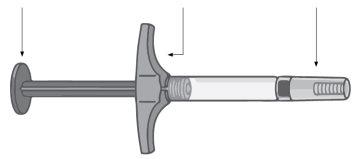
Не используйте предварительно заполненный шприц и позвоните своему врачу или фармацевту, если
- жидкость мутная, имеет цвет или содержит чешуйки или частицы
- истек срок годности (CAD)
- жидкость был заморожен или подвергался прямому солнечному свету
- предварительно заполненный шприц был уронен или раздавлен
Не снимайте наконечник иглы до момента инъекции. Храните Хумиру вне поля зрения и досягаемости детей.
ШАГ 1 Выньте Хумиру из холодильника. Оставьте Хумиру при комнатной температуре в течение 15-30 минутперед инъекцией.
| |
ШАГ 2 Шприц
Салфетка | Проверьте срок годности (CAD). Неиспользуйте предварительно заполненный шприц, если срок годности (CAD) уже истек. На гладкой и чистой поверхности положите:
Вымойте руки и высушите их. |
ШАГ 3 Места инъекции
Места инъекции | Выберите место на теле для инъекции:
Очистите место инъекции спиртовой салфеткой с круговыми движениями.
|
ШАГ 4
| Держите предварительно заполненный шприц одной рукой. Проверьте жидкость в шприце.
Осторожно снимите наконечник иглы другой рукой. Выбросьте наконечник иглы и не используйте его повторно.
|
ШАГ 5
| Держите предварительно заполненный шприц с иглой, направленной вверх.
Медленно нажмите на поршень, чтобы выпустить воздух через иглу
|
ШАГ 6
| Держите корпус шприца одной рукой между большим и указательным пальцами, как если бы вы держали ручку. Зажмите кожу в месте инъекции другой рукой, чтобы она поднялась и была надежно зафиксирована. |
ШАГ 7
| Вставьте иглу в кожу под углом примерно 45 градусов с коротким и быстрым движением.
Медленно нажмите на поршень до конца, пока не будет введена вся жидкость и шприц не будет пуст. |
ШАГ 8
Вата | Когда инъекция будет завершена, медленно вытащите иглу из кожи, сохраняя шприц под тем же углом. После завершения инъекции положите вату или марлю на кожу в месте инъекции.
|
ШАГ 9 Выбросьте предварительно заполненный шприц в контейнер для специальных отходов, как указано вашим врачом, медсестрой или фармацевтом. Никогдане надевайте наконечник иглы обратно.
Наконечник иглы, спиртовая салфетка, вата или марля, блистер и упаковка могут быть выброшены в домашний мусор. |
- Страна регистрации
- Активное вещество
- Требуется рецептДа
- Производитель
- Информация носит справочный характер и не является медицинской рекомендацией. Перед приемом любых препаратов проконсультируйтесь с врачом. Oladoctor не несет ответственности за медицинские решения, принятые на основе этого контента.
- Аналоги Хумира 40 мг раствор для инъекций в предварительно заполненном шприцеФорма выпуска: ИНЪЕКЦИОННЫЙ РАСТВОР, 20 мгАктивное вещество: АдалимумабПроизводитель: Amgen Europe B.V.Требуется рецептФорма выпуска: ИНЪЕКЦИОННЫЙ РАСТВОР, 20 мгАктивное вещество: АдалимумабПроизводитель: Amgen Europe B.V.Требуется рецептФорма выпуска: ИНЪЕКЦИОННЫЙ РАСТВОР, 40 мгАктивное вещество: АдалимумабПроизводитель: Amgen Europe B.V.Требуется рецепт
Аналоги Хумира 40 мг раствор для инъекций в предварительно заполненном шприце в других странах
Лучшие аналоги с тем же действующим веществом и терапевтическим эффектом.
Аналог Хумира 40 мг раствор для инъекций в предварительно заполненном шприце в Ucrania
Врачи онлайн по Хумира 40 мг раствор для инъекций в предварительно заполненном шприце
Консультация по дозировке, побочным эффектам, взаимодействиям, противопоказаниям и продлению рецепта на Хумира 40 мг раствор для инъекций в предварительно заполненном шприце – по решению врача и с учетом местных правил.



